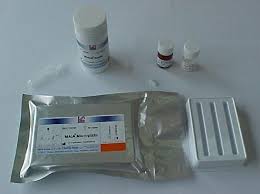Liofilchem® Microplate Acetylcholinesterase Inhibition Assay (MAIA) Pesticide MultiTest
Catalog No :
CAS Number :
Brand :
In Stock
Specifications:
| Application | Colorimetric Assay |
| Storage Temperature | 2-8°C |
| Product Type | Assay Kits |
| Product Brand | Liofilchem |
| Product Grade | Microbiology grade |
The Liofilchem® MAIA Pesticide MultiTest is a colorimetric assay designed for the detection of organophosphate, organochloride, and carbamate pesticide residues in water, food, and beverages. Using the Acetylcholinesterase (AChE) Inhibition Assay (MAIA), this test system provides a semi-quantitative screening method for identifying pesticide contamination, making it an essential tool for food safety and environmental monitoring.
Key Features:
- Comprehensive Detection:
- Targets three major pesticide families: organophosphate, organochloride, and carbamate residues.
- Effective for hydro-acetonitrilic extracts of solid and liquid food matrices.
- Colorimetric Assay:
- Based on the inhibition of acetylcholinesterase (AChE) activity by pesticide molecules.
- Utilizes acetylthiocholine as a substrate and a chromogenic detector for thiocoline, enabling visual or absorbance-based detection.
- Dual Analysis Options:
- Visual Evaluation: Compare the yellow intensity in sample wells to control wells.
- Quantitative Analysis: Use a microplate reader to measure absorbance and calculate pesticide titers.
- Convenient and Ready-to-Use:
- Includes all necessary reagents and tools for the test:
- MAIA microplate.
- MAIA STARTER and MEDIUM solutions.
- MAIA salts.
- Designed for ease of use with minimal preparation time.
- Includes all necessary reagents and tools for the test:
- Accurate and Reliable:
- Provides precise screening results with an easy-to-follow workflow.
- Detects pesticide concentrations through a biological mechanism, ensuring specificity and relevance.
Test Procedure:
- Sample Preparation:
- Mix 4 mL of milk or homogenized food sample with 4 mL of acetonitrile.
- Add 2 g of MAIA salts, shake vigorously, and centrifuge at 3,000 rpm for 10 minutes.
- Use the post-centrifugation supernatant as the sample extract.
- Microplate Setup:
- Dispense 100 μL of each sample extract into the designated wells of the MAIA microplate.
- Desiccate the extracts under direct airflow at room temperature.
- Enzyme Preincubation:
- Add MEDIUM solution (prepared by reconstituting a MEDIUM vial with ultrapure water) to all wells.
- Cover the plate with the sealing film and preincubate for 50 minutes on a microplate shaker.
- Reaction Start:
- Add STARTER solution (prepared from the STARTER vial) to all wells except matrix blanks.
- Incubate for 8 minutes, then stop the reaction by adding STOPPER solution.
- Result Interpretation:
- Visual Analysis: Compare the color intensity in sample wells to control wells (yellow intensity inversely proportional to pesticide concentration).
- Microplate Reader: Measure absorbance values to calculate quantitative pesticide titers.
Principle of the Test:
The test uses the AChE inhibition mechanism, wherein pesticides inhibit enzyme activity, reducing the conversion of acetylthiocholine into yellow-colored thiocoline. The intensity of the yellow color is inversely proportional to the pesticide concentration in the sample.
Kit Components:
| Item | Contents |
|---|---|
| MAIA Microplate | 1 plate |
| MAIA STARTER Vials | 10 vials |
| MAIA MEDIUM Vials | 10 vials |
| MAIA Salts | 1 container |
Applications:
- Food Safety Testing:
- Detects pesticide residues in milk, vegetables, fruits, and processed foods.
- Water Quality Analysis:
- Screens for pesticide contamination in drinking and environmental water samples.
- Beverage Testing:
- Evaluates pesticide levels in juices, wines, and other liquid samples.
- Research:
- Used in studies of pesticide impact on food and environmental systems.
Advantages:
- Versatile Detection:
- Applicable to a wide range of food and beverage samples.
- Suitable for both solid and liquid matrices.
- Fast and Efficient:
- Simple workflow with results available within a few hours.
- Dual Evaluation:
- Allows for both visual and quantitative analysis, accommodating varying resource levels.
- Portable and Convenient:
- Ideal for both laboratory and field-based pesticide screening.
Storage and Handling:
- Store kit components at 2–8°C in their original packaging.
- Avoid exposure to direct light or moisture.
- Ensure reagents are used before the expiration date.
Specifications:
| Feature | Details |
|---|---|
| Detection Method | Colorimetric (Visual or Microplate Reader) |
| Target Analytes | Organophosphate, Organochloride, Carbamate Pesticides |
| Applications | Food, Water, Beverage Testing |
| Storage Conditions | 2–8°C |
References:
- ISO 15214: Horizontal methods for food and feed microbiology testing.
- Briggs, M. (1953). J. Dairy Res. 20:36.
The Liofilchem MAIA Pesticide MultiTest offers a comprehensive, reliable, and efficient solution for pesticide residue detection in food, water, and beverages. Its colorimetric assay provides flexible analysis options, making it an invaluable tool for laboratories and quality control teams.




 0
0
